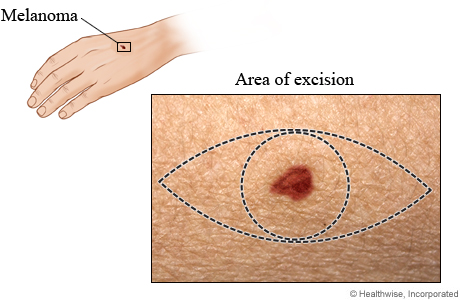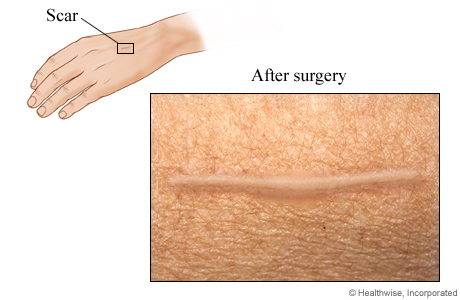Melanoma Excision Surgery
Surgery Overview
Surgery to remove (excise) a melanoma removes the entire melanoma along with a border (margin) of normal-appearing skin. The width of the border of normal skin removed depends on the depth of the melanoma. More tissue, usually skin and fat, is also removed from under the melanoma.
- Small excisions may be closed with stitches and heal without problems.
- Large excisions or those located on the hands, face, or feet may require a skin graft to close the wound after surgery.
The type of anesthetic used for your surgery depends on the size and location of the melanoma. Surgery on small, easily reached melanomas may require only a local anesthetic. Surgery for larger melanomas may require general anesthesia.
How It Is Done


Surgery to remove (excise) melanoma removes the cancer and a border of healthy tissue. In the "Area of excision" picture:
- The inner circle represents the melanoma and healthy tissue that are excised.
- An eye-shaped incision (cut) is often done so that the surgical site can be neatly closed.
If the excision is small, the skin may be closed with stitches after surgery. The "After surgery" picture shows the usual shape of the scar after surgery to remove a small melanoma.
If the excision is large, a skin graft may be needed.
Other ways of removing a melanoma can leave a round scar or a scar shaped a little like the letter "Z."
What To Expect
Recovery after surgery to remove a melanoma depends upon the site and extent of surgery. The wound may take longer to heal if reconstructive surgery techniques such as skin grafts are used.
Why It Is Done
Surgery is the most common treatment for melanoma. Sometimes lymph nodes may be removed at the same time to check them for cancer. Surgery also may be done to remove lymph nodes that have cancer or to remove tumors that may have spread to other parts of the body.
How Well It Works
Surgery to remove the melanoma usually cures melanoma if it is found early. Surgery and other treatments may be needed if cancer is found in the nearby lymph nodes.
Surgery may be used as part of the treatment for metastatic melanoma. In certain cases, surgery can help with long-term survival. And surgery may help relieve symptoms.
Risks
Risks of surgery to remove melanoma include:
- Infection.
- Scarring.
- Bleeding.
- Rejection of the skin graft.
Credits
Current as of: November 16, 2023
Author: Ignite Healthwise, LLC Staff
Clinical Review Board
All Healthwise education is reviewed by a team that includes physicians, nurses, advanced practitioners, registered dieticians, and other healthcare professionals.
Current as of: November 16, 2023
Author: Ignite Healthwise, LLC Staff
Clinical Review Board
All Healthwise education is reviewed by a team that includes physicians, nurses, advanced practitioners, registered dieticians, and other healthcare professionals.


